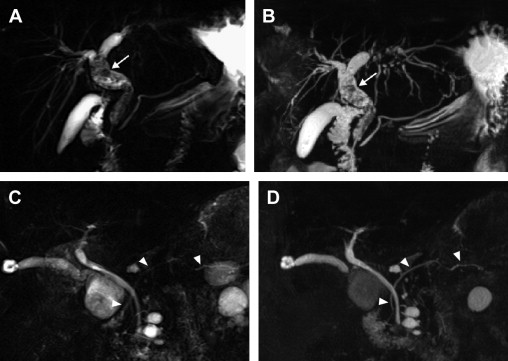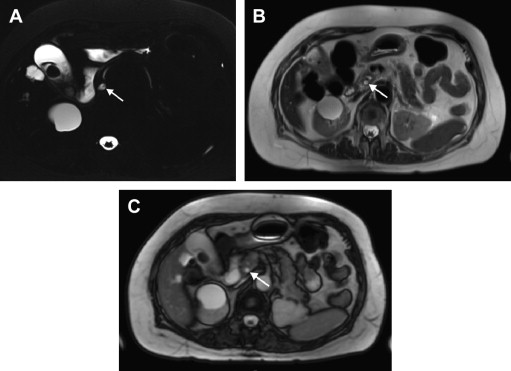MR imaging is a noninvasive, radiation-free imaging method for evaluation of the biliary system. Continued advancements in MR imaging system hardware and sequence design, coupled with novel gadolinium chelate agents, allow for a detailed evaluation of the bile ducts and surrounding soft tissues. New hepatocyte-specific contrast agents may hold utility in the anatomic and functional evaluation of bile duct injury. MR imaging is also the imaging method of choice for bile duct tumor diagnosis, staging, and presurgical planning. Familiarity with the proper methodology of MR image acquisition and interpretation is critical for optimized diagnostic assessment.
Key points
- •
MR imaging is a noninvasive, radiation-free imaging method for evaluation of the biliary system. Continued advancements in MR imaging system hardware and sequence design, coupled with novel gadolinium chelate agents, allow for a detailed evaluation of the bile ducts and surrounding soft tissues.
- •
The full diagnostic potential of MR imaging is achieved by coupling the luminal evaluation of fluid-sensitive MR cholangiopancreatography (MRCP) sequences with the soft tissue assessment of dynamic, contrast-enhanced three-dimensional T1-weighted (T1W) gradient echo (GRE) sequences and shorter echo, single-shot T2-weighted (T2W) sequences.
- •
The capability for soft tissue assessment is a specific strength of MR imaging over luminal-only imaging techniques, such as endoscopic retrograde cholangiopancreatography (ERCP).
- •
Choledocholithiasis is the most common cause for bile duct obstruction and is well-depicted on MRCP sequences, whereas associated inflammatory changes in the bile duct wall and hepatic parenchyma are demonstrated on sequences highlighting soft tissue detail.
- •
New hepatocyte-specific contrast agents may hold utility in the anatomic and functional evaluation of bile duct injury. MR imaging is also the imaging method of choice for bile duct tumor diagnosis, staging, and presurgical planning.
- •
Familiarity with the proper methodology of MR image acquisition and interpretation is critical for optimized diagnostic assessment.
Introduction
The biliary system may be afflicted by a wide range of benign and malignant pathology, and is a major source of morbidity and mortality in the United States. A variety of disease processes affecting the bile ducts may have similar clinical presentations, and medical imaging plays a central role in the diagnosis and treatment decision pathways for these patients. Although ultrasound and computed tomography are frequently used modalities for imaging of biliary disease (especially in the emergency setting), the soft tissue capabilities of MR imaging are ideally suited for providing a comprehensive analysis of bile duct pathology. With continued advancements in hardware innovation and sequence design, coupled with new gadolinium-based chelate agents that are excreted by the biliary system, MR imaging continues to assume a central role in the diagnostic work-up of bile duct diseases. This article describes standard and newly developed MR imaging methods for imaging the biliary tree. An array of benign and malignant biliary pathology is presented, with concentration on the MR imaging features and specifics of optimized image interpretation.
Introduction
The biliary system may be afflicted by a wide range of benign and malignant pathology, and is a major source of morbidity and mortality in the United States. A variety of disease processes affecting the bile ducts may have similar clinical presentations, and medical imaging plays a central role in the diagnosis and treatment decision pathways for these patients. Although ultrasound and computed tomography are frequently used modalities for imaging of biliary disease (especially in the emergency setting), the soft tissue capabilities of MR imaging are ideally suited for providing a comprehensive analysis of bile duct pathology. With continued advancements in hardware innovation and sequence design, coupled with new gadolinium-based chelate agents that are excreted by the biliary system, MR imaging continues to assume a central role in the diagnostic work-up of bile duct diseases. This article describes standard and newly developed MR imaging methods for imaging the biliary tree. An array of benign and malignant biliary pathology is presented, with concentration on the MR imaging features and specifics of optimized image interpretation.
MR imaging methodology
MR Cholangiopancreatography
MR cholangiopancreatography (MRCP) is the key MR imaging sequence for luminal imaging of the biliary tree. By using a heavily T2-weighted (T2W) sequence with echo times in excess of 700 milliseconds, MRCP provides excellent anatomic detail of the fluid-containing structures of the abdomen, and is ideally suited for imaging of the bile ducts. Several different technical approaches to MRCP may be pursued. Conventional two-dimensional MRCP sequences constitute the fastest and most frequently used method. Single-shot, turbo spin echo sequences (obtained through the application of a single 90-degree pulse followed by an echo train of multiple 180-degree pulses with separate phase-encoding gradients) are resistant to patient motion and produce reliable image quality even in sick and freely breathing patients. Two-dimensional MRCP images may be acquired as either a thick-section coronal slab image and/or thin, multisection stacked images. The coronal slab MRCP is typically a 5- to 6-cm thick section that may be acquired in a short breath hold of 5 seconds, providing a single image overview of the biliary and pancreatic ductal systems. A potential limitation of the thick slab technique is the possibility of partial volume averaging effects that may obscure small filling defects within the biliary tree. This limitation may be overcome by the additional acquisition of contiguous, axial multisection MRCP images through the biliary tree. When acquired with a single-shot technique, this sequence is quite resistant to patient motion and may better demonstrate small calculi in the biliary system.
Three-dimensional acquisition MRCP methods are also available that produce high-quality, isotropic resolution images of the biliary system. Using a three-dimensional T2W turbo-spin echo method with echo times in excess of 700 milliseconds, a volumetric data set may be produced with 1-mm thin sections and no intersection gaps or image misregistration effects. Postprocessing of this raw, volumetric data may be performed with multiplanar reconstruction to produce thin section data in multiple imaging planes, in addition to maximum intensity projections with volume rendering to produce a rotating, overview image of the biliary system. Image acquisition times for the three-dimensional technique are variable, although they are typically on the order of 4 to 8 minutes. Respiratory triggering is a necessary component of this sequence because of the longer image acquisition time. Triggering methods vary, but a common technique tracks diaphragmatic motion in real time to trigger image acquisition at specific points in the respiratory cycle. Variability of the respiratory cycle and the ability of each breath to meet the set trigger thresholds are factors that directly influence the time of image acquisition.
The criteria for selection of a three- or two-dimensional MRCP technique may vary from center to center ( Fig. 1 ). Three-dimensional acquisition methods offer the strengths of excellent contrast and improved signal-to-noise ratios relative to the two-dimensional techniques. In addition, the high-resolution method of a three-dimensional acquisition allows for more reliable distinction of small biliary calculi from flow artifacts than may be seen with the two-dimensional method. However, the larger time investment required for three-dimensional image acquisition may discourage some centers from routine use of this technique. Additional soft tissue imaging obtained as part of a comprehensive MR examination of the bile ducts frequently provides additional diagnostic information that may reduce the benefits of the three-dimensional MRCP technique. In patients with irregular respiratory cycles that are difficult to capture by the navigator pulse, there may be a significant time investment in a three-dimensional image acquisition that is susceptible to ghosting and blurring artifacts. In comparison, two-dimensional methods tend to be much more robust and resistant to motion degradation.

Preimaging patient instructions vary from center to center. A common imaging protocol instructs patients to fast for 4 hours before the MR imaging to reduce the amount of fluid in the stomach and duodenum, which may obscure visibility of the biliary system on MRCP sequences. Other centers routinely use negative oral contrast agents (eg, blueberry juice or iron oxide agents) to reduce overlapping T2 signal in the stomach and proximal small bowel. However, the benefits of these preimaging instructions are reduced when soft tissue imaging becomes a standardized part of abdominal imaging protocols for bile duct imaging.
Soft Tissue Imaging
Despite the many benefits of MRCP, obtaining this sequence alone is insufficient for a comprehensive analysis of the biliary system. MRCP is a luminal technique and does not provide adequate analysis of the surrounding soft tissues that are frequently a contributor to biliary pathology. It is our view that an imaging evaluation of the bile ducts is incomplete without dynamic, T1-weighted (T1W) contrast-enhanced three-dimensional gradient echo (GRE) sequences coupled with shorter echo, single-shot T2W sequences. MRCP is simply one additional component of a comprehensive MR imaging examination that has the ability not only to diagnose the presence of biliary obstruction, but also to provide a specific pathologic cause for the obstruction.
T2W and steady-state free precession imaging
Although MRCP sequences provide a luminal depiction of the biliary system, T2W sequences with shorter echo times (approximately 80–90 milliseconds at 1.5 T) combine the advantages of producing high signal in the biliary system with the ability to assess the surrounding soft tissues. When acquired with a single-shot technique, these sequences are motion insensitive and produce consistently high image quality. The T2W images are prone to through-plane flow artifacts, manifesting as foci of signal loss in fluid-containing structures. These flow artifacts are typically centrally located within the extrahepatic bile duct on axial images and are not present on coronal sequences. Steady-state free precession sequences, like T2W sequences, produce bright signal in fluid-containing structures. However, even when acquired with a single-shot technique, steady-state free precession sequences are less prone to this flow void artifact and may be helpful to distinguish between small stones and flow artifact in questionable cases ( Fig. 2 ).

T1W imaging
Dynamic, fat-saturated gadolinium chelate–enhanced T1W three-dimensional GRE imaging is a critical portion of a comprehensive MR imaging evaluation of the intrahepatic and extrahepatic bile ducts. This technique is performed during a single breath hold and is thus sensitive to motion artifact. Recently, newer T1W three-dimensional GRE sequences have been developed that use a radial pattern of k-space filling, reducing flip angle inaccuracies and motion artifacts and thus preserving image quality even in freely breathing patients.
Precontrast T1W images are helpful in demonstrating blood products, cholesterol-laden stones, and sludge in the biliary system. In addition, interruption of bile flow by obstructive processes causes accumulation of bile acids in the hepatic parenchyma, inciting a hepatic inflammatory response and hepatocyte injury. A dynamic, arterial-phase sequence acquired with a bolus tracking method frequently demonstrates these changes of active hepatitis. These findings are typically only apparent on a properly timed arterial-phase acquisition, normalizing on subsequent venous and delayed interstitial phase images. In addition, infiltrative tumor growing along the duct wall and abnormal soft tissues causing extrinsic compression of the bile ducts may be reliably differentiated with dynamic postcontrast imaging.
Hepatobiliary-Specific Contrast Agents
Although most gadolinium chelate agents have a primarily extracellular biodistribution with renal clearance, a few agents have come to market in recent years that have a mixture of renal and hepatic clearance. Gadoxetate disodium (Gd-EOB-DTPA; Eovist or Primovist, Bayer Healthcare, Leverkusen, Germany) is a liver-specific agent that is excreted 50% by the liver and 50% by the kidneys in patients with normal hepatic and renal function. This agent is transported from the extracellular space into the hepatocytes by an ATP-dependent transporter and subsequently excreted into the bile duct canaliculi, shortening the T1 of fluid in the bile ducts and producing high signal on T1W sequences. Gd-EOB-DTPA is typically excreted into the biliary system by 7 to 10 minutes, with serial imaging usually obtained through 20 minutes postinjection. This feature of contrast excretion into the biliary system has allowed for new methods of bile duct imaging using high-resolution, isotropic T1W three-dimensional GRE sequences as an alternative to T2W three-dimensional MRCP. This technique finds promising application for preoperative planning and for assessment of bile duct injuries. It should be noted that the optimum excretion of a hepatocyte-specific agent into the bile duct canaliculi depends on properly functioning hepatocytes. Inflamed liver tissue, whether related to intrinsic acute or chronic hepatitis or alternatively bile duct obstruction, may not take up and excrete the contrast into the biliary system in a reliable fashion. Gadobenate dimeglumine (Multihance; Bracco Diagnostics, Monroe Township, NJ, USA) is another contrast agent with hepatic uptake and excretion, producing signal in the biliary system after 1 to 2 hours postinjection, but to a much lesser extent than Gd- EOB-DTPA. Mangafodipir trisodium (Teslascan; Nycomed, Zurich, Switzerland) is a paramagnetic manganese-based agent that also demonstrates some biliary excretion, but was recently withdrawn from the market because of low demand.
The evolving role of MR imaging and endoscopic retrograde cholangiopancreatography
Endoscopic retrograde cholangiopancreatography (ERCP) is a commonly used procedure for evaluation of the biliary tree. Advantages of ERCP include the ability to perform therapeutic interventions including cytologic brushings, stone extraction, and stent placement for obstructive diseases. As a diagnostic imaging modality, ERCP has several disadvantages compared with MR imaging. ERCP is an invasive methodology, and complications include postprocedure pancreatitis, bleeding, cholangitis, and perforation. A large, multicenter review found the overall ERCP complication rate to be 6.85% and the ERCP-related mortality rate to be 0.33%, with some studies reporting 1%. Performed by opacifying the biliary system with iodinated contrast, ERCP only provides a luminal evaluation of the bile ducts and frequently fails to visualize the biliary system proximal to a point of obstruction or high-grade narrowing. ERCP demonstrates even more limited application in the setting of biliary enteric anastomoses or other surgically altered anatomy. In the evaluation of malignant biliary disease, ERCP cannot assess for extraductal disease and is limited in tumor staging. By contrast, MR imaging is a noninvasive imaging technique with no radiation or need for sedation, and provides a comprehensive assessment of not only the lumen of the biliary system but also the surrounding soft tissues.
Several studies have demonstrated the ability of MR imaging to diagnose biliary diseases, with sensitivities and specificities greater than 90%, comparable with ERCP. An optimal imaging strategy uses MR imaging as the initial diagnostic modality for the evaluation of the bile ducts. When intervention is required, the MR imaging findings may be used as a roadmap for subsequent endoscopic intervention. This approach results in overall cost savings for the medical system in addition to reducing the number of patients exposed to procedural complications.
Benign hepatobiliary pathology
Biliary Obstruction
Choledocholithiasis
Stones in the biliary tree are the most frequent cause of bile duct obstruction. MR imaging demonstrates sensitivity (81%–100%) and specificity (85%–100%) for the diagnosis of biliary stones that is comparable with ERCP and superior to computed tomography and ultrasound. On T2W images, biliary calculi present as hypointense filling defects surrounded by bright fluid ( Fig. 3 ). Stones as small as 2 mm are reliably identified in dilated and nondilated systems. Smaller calculi are best imaged with thin-section MRCP images and may be obscured by thick-section slab or maximum intensity projection reconstructions secondary to volume averaging.

MR imaging aids in the diagnosis of Mirizzi syndrome, which occurs when a stone impacted within the cystic duct results in obstruction of the adjacent common hepatic duct ( Fig. 4 ). MR imaging not only highlights the stone within the cystic duct but also details the surrounding inflammatory signal, allowing reliable differentiation from cholangiocarcinoma.
When interpreting the biliary system on MR imaging, note should be made of several potential mimics that may resemble bile duct calculi. As previously noted, rapid flow of bile may produce a flow void artifact within the duct on single-shot T2W images, which may be misinterpreted as a calculus. Pneumobilia may also present as a filling defect in the biliary system, but is differentiated from a dependently layered calculus by its nondependent position within the biliary tree and/or the presence of an air-fluid level. In addition, air demonstrates “blooming” artifact on dual-GRE, in-phase images because of the effects of gas on the local magnetic field ( Fig. 5 ). Blood clots may be difficult to differentiate from biliary calculi on T2W images, but on noncontrast T1W imaging they present with high signal intensity ( Fig. 6 ).
Portal biliopathy
Portal biliopathy is a term used for obstruction of the bile ducts from extensive varices at the porta hepatis, typically a result of portal venous thrombus. Chronic occlusion of the portal vein leads to cavernous transformation with distention of several venous plexuses that extend along the biliary tree, and may cause bile duct obstruction through extrinsic compression. On MR imaging, portal biliopathy manifests as smooth narrowing and scalloping of the bile duct wall, which is compressed by the surrounding venous collaterals ( Fig. 7 ). Although MRCP sequences depict the bile duct obstruction, the key to accurate diagnosis is identification of the extensive venous collaterals on soft tissue imaging, clearly detailed on dynamic contrast-enhanced T1W three-dimensional GRE imaging.
Cystic Disease of the Bile Ducts
Choledochal cysts are congenital cystic dilatations of the biliary tree, which were first classified by Alonso-Lej in 1959 and expanded to a five-category system by Todani in 1977 ( Fig. 8 ). Choledochal cysts are distinguished from obstruction by the cystic morphology and the localized pattern of dilatation.

Stay updated, free articles. Join our Telegram channel

Full access? Get Clinical Tree




